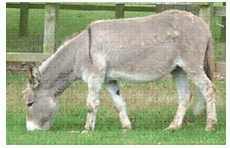I have not investigated donkeys‘ feet sufficiently to be able to advise on them but I would like to make one or two points.
| For advice on trimming see article "Trimming Donkeys Feet" by John Fowler, (formerly vet at The Donkey Sanctuary in Devon). Equine Veterinary Education Manual No.4 Dec. 1998 "The Equine Hoof" |
 Many of the donkeys I see are suffering from chronic laminitis.
Many of the donkeys I see are suffering from chronic laminitis.
So many donkeys are kept as companions and never do any work. It is highly likely that many suffer from Equine Metabolic Syndrome, from over feeding and lack of exercise. Farriers may find trimming donkey feet difficult due to their size and, in some cases, awkwardness. The farrier may not be experienced in trimming donkey feet and often the time between trimmings will be too long.
All these factors are likely to contribute to the number of donkeys that develop laminitis.
Donkey feet are certainly different from those of horses. They have a distinctly U-shaped foot. The layer of compact tubules, that is relatively thin in the horse hoof, extends to over half the thickness of the wall. Apparently the front third of the sole should be in contact with the ground (J.Fowler) Donkey feet are generally 5 - 10 more upright than horses‘ feet, but should still have a straight foot pastern axis. (J.Fowler)
The impression I have is that donkey feet are often trimmed too upright and because of this they not infrequently have a broken-forward foot pastern axis.
The coronet line to dorsal wall angle is, as in the case of horses and ponies, pretty consistent at 105 . I suggest that if their feet are trimmed so that their dorsal wall is at too sharp an angle to the ground, the greater forces down the dorsal surface of the pedal bone will make them more prone to laminitis and recurrence of the condition. (See Strasser's Plastic Sheet & How should we trim the chronic founder foot).

 The left fore foot of the donkey seen grazing in the photographs, before and after trimming (please roll mouse over images).
The left fore foot of the donkey seen grazing in the photographs, before and after trimming (please roll mouse over images).